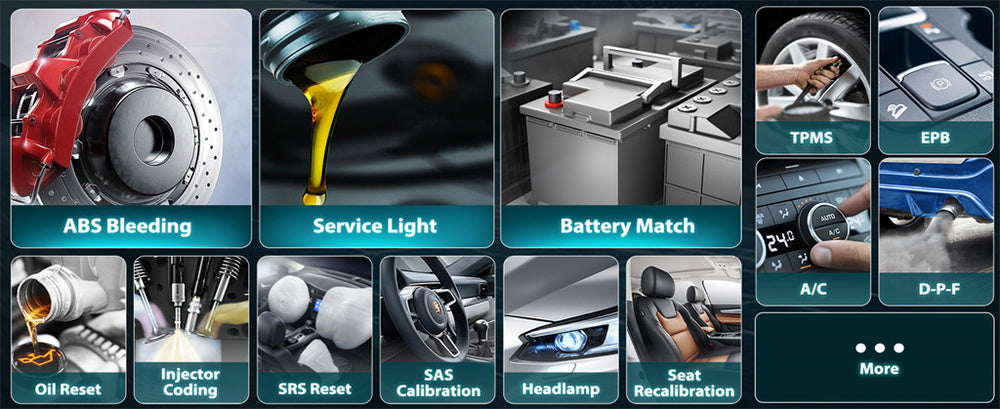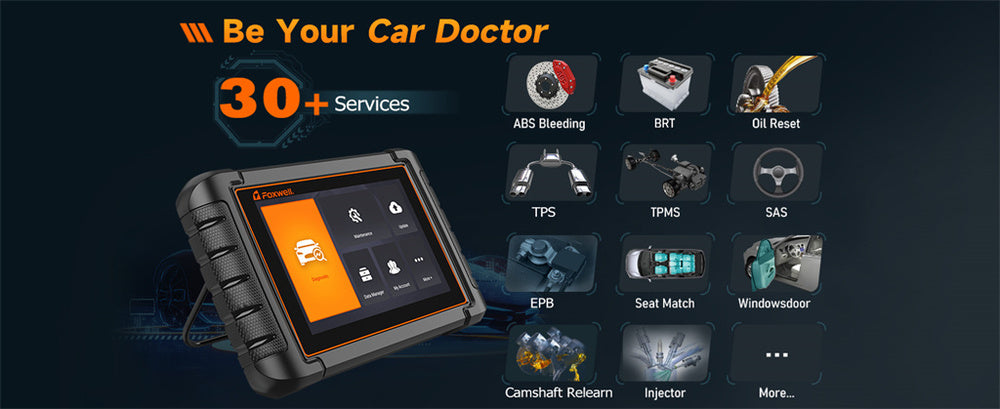For individuals passionate about do-it-yourself projects, having a car auto scanner is a valuable tool that allows you to troubleshoot and fix vehicle issues independently. Whether you're a mechanic or simply someone who enjoys tinkering with cars as a hobby, knowing how to utilize a scanner effectively can help you save time, money and frustration.
Devices like the Foxwell NT1009 provide features, making them an excellent option for those interested in deeper into vehicle maintenance. Here are seven detailed recommendations to help you get the most out of your car auto scanner.
Select the Appropriate Scanner for Your Requirements

Not all scanners are the same. It's essential to choose one that meets your needs for diagnostics. Consider the aspects:
- Compatibility: Make sure the scanner is compatible with the protocols used by your vehicle's make, model, and year. Some scanners are universal, while others are designed for brands.
- Features:Seek out features such as code reading and clearing capabilities, data display, and system testing abilities. Advanced scanners like the Foxwell NT1009 come equipped with directional controls that activate components for functional testing.
- Ease of Use: Opt for user interfaces that include instructions and easy navigation to make the learning process smoother. Touchscreen options and devices with displays can improve usability.
- Durability: When selecting a scanner, prioritize models designed to withstand garage conditions. Look for builds with casing and long cables for added flexibility.
- Budget: Scanners come in various models ranging from basic to features. Consider your budget. Choose a scanner that offers functionalities within your price range.
Get Familiar with OBD II Codes
Having a grasp of OBD II (On Board Diagnostics) codes is essential for understanding the information provided by your scanner. Here's a comprehensive overview;
- P Codes (Powertrain): These codes relate to engine, transmission, and emissions systems. Codes like P0300 typically indicate misfires, while P0420 may signal issues with the converter.
- B Codes (Body): These codes are associated with components such as airbags, seatbelts and interior electronics. For instance, B1231 could indicate a problem with an airbag sensor.
- C Codes (Chassis): These codes focus on ABS, suspension, and steering systems. A code like C1235 might indicate a fault in the wheel speed sensor.
- Vehicle Communication Issues (Network): U Codes address problems within the vehicle's communication system, such as lost communication with a module (U0100 for lost communication with the ECM/PCM).
Tips for Interpreting Codes:
- Source Reliability: Having a code dictionary or utilizing online resources is recommended.
- Context Matters: Consider the symptoms and circumstances associated with the code. For instance, a misfire code could indicate issues with spark plugs, fuel injectors, or even a possible vacuum leak.
Keep Your Scanner Software Updated
Manufacturers regularly issue software updates to enhance scanner performance and expand support for vehicle models. Here's how to ensure your scanner remains current;
- Update Check: Visit the manufacturer's website periodically to check for software updates. Some scanners, like the Foxwell NT1009, may also notify you of any updates.
- Download and Install: Follow the provided instructions to download and install updates from the manufacturer. This typically involves connecting your scanner to a computer via USB or using Wi-Fi/Bluetooth, if supported.
- Update Benefits: Software updates can improve capabilities and address bugs. Ensure your scanner can read the latest codes for newer vehicle models.
Get some practice with reading and understanding data
Before you dive into fixes, get comfortable using your scanner by following these steps;
- Complete a Diagnost: Hook up the scanner to the OBD II port, usually found beneath the dashboard. Run a scan to fetch stored and pending codes.
- Decode the Code: Jot down. Keep a record of the retrieved codes. Use the scanners provided by the library or online sources to interpret them.
- Live Data Monitoring: Keep an Eye on the Data. Spend time observing data streams. Monitor parameters like engine RPM, coolant temperature, and oxygen sensor readings. This real-time data can help you differentiate between unusual readings.
Practical Exercise:
Simulate Scenarios: Deliberately disconnect a sensor. Trigger an issue (such as removing a gas cap) to see how the scanner responds. This practice will assist you in diagnosing and clearing codes in real-world situations.
Utilize the Scanner for Basic Maintenance Checks
Your scanner is not just for reading trouble codes; it can also be used for maintenance checks, such as;
- Battery Health: Check the battery voltage and charging system health. A functioning battery typically shows around 12.6 volts when the engine is off and 13.7 14.7 volts when running.
- Emissions Readiness: Ensure your car is ready for a smog check by checking all the monitors, such as the EVAP system, O2 sensors, and catalytic converter, to ensure they are in the "state.
- Sensors and Actuators: Monitor real-time data and responses to check that sensors such as oxygen and MAF sensors, along with actuators like fuel injectors and solenoids, are working properly.
Maintenance Tips
- Schedule Regular Checks: Make scanner checks a part of your maintenance schedule, such as every other month.
- Keep Records: Maintain a log of the codes and data collected during each check to monitor any issues arising over time.
Join Online Communities and Forums
Online communities are a resource for DIY enthusiasts in automotive diagnostics and repairs. Participating in forums and social media groups dedicated to these topics can offer advantages;
- Ask Questions: If you encounter codes or complex problems, don't hesitate to ask questions. Experienced users can provide insights and solutions.
- Share Experiences:Share your findings and successful repairs with others. This helps enthusiasts and allows you to receive feedback on your methods.
- Stay Informed: Follow discussions to learn about the tools, techniques, and common issues related to your specific vehicle model. By using these suggestions, car enthusiasts can enhance the performance of their diagnostic scanners, making car repairs and maintenance more effective and enjoyable. Enjoy working on your car!
Don’t Rely Solely on the Scanner
While a diagnostic scanner is a powerful tool, it’s not infallible. Complement it with other diagnostic methods:
- Use Other Tools: Basic diagnostic tools such as a multimeter, vacuum gauge, or pressure tester can provide additional insights.
- Cross-Reference Information: Verify scanner data with vehicle service manuals, repair databases, or professional diagnostic software.
- Perform Visual Inspections: Check for obvious issues like loose wires, damaged hoses, or fluid leaks. Sometimes, physical damage or wear can be the root cause of a code.
Additional Tips:
- Test Drive: After clearing codes and making repairs, take the vehicle for a test drive to ensure the issue is resolved and no new codes appear.
- Professional Consultation: If you encounter persistent or complex issues, don’t hesitate to consult with a professional mechanic.
By following these detailed tips, DIY enthusiasts can maximize the effectiveness of their car auto diagnostic scanners, making automotive repairs and maintenance a more efficient and satisfying endeavor. Happy wrenching!

Conclusion
Having a diagnostic scanner is crucial for any DIY enthusiast. With the knowledge and strategy, you can utilize this device to maintain your vehicle's condition and better understand its functionality. Be sure to select the scanner, keep it up to date, and improve your abilities through practice and interacting with fellow enthusiasts.
FAQs
What should I look for in a car diagnostic scanner?
Look for compatibility with your vehicle, ease of use, and features like real-time data and error code explanations.
How do I interpret error codes on a diagnostic scanner?
Refer to the scanner's manual or online databases. Some scanners provide detailed explanations and potential fixes for error codes.
Can a diagnostic scanner help with regular maintenance?
Yes, a scanner can monitor engine performance, detect issues early, and help with routine maintenance tasks like checking sensor functions.




Leave a comment
This site is protected by hCaptcha and the hCaptcha Privacy Policy and Terms of Service apply.